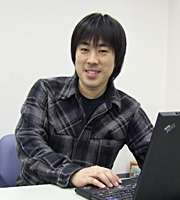In this project, I will investigate, at the molecular level, "interplay
between the interacting schemes of bio-molecules in solution and their specific
functions" and "a self-organization mechanism of proteins into
higher-order structures". These subjects are crucial because they are
closely related not only to solution chemical physics, soft-matter/colloid
physics, and biophysics, but to a wide range of interdisciplinary fields,
e.g., life science and medical applications.
For instance, to clarify the diversity of hydrophobic interaction,
which is known to be a major driving force of self-organization phenomena
of all amphiphilic molecules, stabilization of higher-order structures of
proteins, and so forth, we need to seek microscopic aspects of liquid water,
such as degree of freedom for its translational motions and microscopic
frictional forces acting on the cooperative rearrangement hydrogen-bond
network. On the one hand, if jumping to the hierarchy of colloid, protein-protein
interactions in vivo is considered not to be independent of the concentration
of other coexisting molecules; a remarkable influence of "depletion
interaction", i.e., an apparent attractive interaction between large
particles under coexistence of large and small colloidal particles, is expected
to emerge.
Using novel experimental and analytical approaches, mainly based on
small-angle scattering, dynamic and static light scattering, and dielectric
spectroscopy, I will try to establish the system that enables us to pursuit
a variety of phenomena occurring on extremely wide time- and length-scale.
This way, I cultivate the frontiers of solution chemical physics, soft-material/colloid
physics, and biological physics. I believe that there is possibility that
in the future, we are able to understand, with certain universality, such
diverse phenomena from a universal standpoint where each hierarchy is transcended.
At the same time, I am hoping to contribute, from the viewpoint of
physics, to the development of bio-inspired materials aiming at medical
applications, like artificial oxygen carriers.
Profile

Takaaki SATO
- Research Area:
- Interdisciplinary fields, involving Chemical Physics of Solution, Soft-matter and Colloid Physics, and Biological Physics
- Keywords:
- Water, Nano-biomolecules, Functional Polymers, Bio-inspired Nano-materials for Medical Applications
- Contact:
- 3-15-1 Tokida, Ueda-shi, Nagano-ken
Japan 386-8567
Tel: +81-0268-21-5586
E-mail: takaakis[at-mark]shinshu-u.ac.jp
Employment Experience:
1998.7-2000.3:
Research Fellow of the Japan Society for the Promotion
of Science (DC2)
2001.4-2004.9:
Research Fellow of the Japan Society for the Promotion
of Science (PD)
2001.4-2004.9:
Lecturer (Faculty of Science and Engineering, Waseda
University, Japan)
2006.10-2007.11:
Lecturer (Research Institute for Science and Engineering, Waseda University, Japan)
Education:
1991.4-1995.3:
Department of Applied Physics, School of Science and
Engineering, Waseda University, , Bachelor degree of Engineering
1995.4-1996.3:
Division of Pure and Applied Physics, Graduate School
of Science and Engineering, Waseda University, Master degree of Science
1996.4-1999.3:
Division of Pure and Applied Physics, Graduate School
of Science and Engineering, Waseda University, Doctor aegree of Science
1999.3:
Dr. (Sci.) Waseda University
Selected Publications:
- T. Sato, T. Komatsu, A. Nakagawa, and E. Tsuchida, ‘Induced long-range attractive potentials of human serum albumin by ligand binding,’ Phys. Rev. Lett., 98, 208101 (1-4) (2007).
- T. Sato, H. Sakai, K. Sou, R. Buchner, and E. Tsuchida, ‘Poly(ethylene
glycol)-conjugated phospholipids in aqueous micellar solutions: hydration,
static structure, and interparticle interactions,’
J. Phys. Chem. B, 111, 1393-1401 (2007). - T. Fukasawa, T. Sato, J. Watanabe, Y. Hama, W. Kunz, and R. Buchner, ‘The relation between dielectric and low-frequency Raman spectra of hydrogen-bond liquids’, Phys. Rev. Lett., 95, 197802 (1-4) (2005 ).
- Sec.1-2, ‘Elucidation of Self-assembly Structures
using Small-angle X-ray Scattering Technique’
(in Japanese) in ‘The latest functions of Surfactant and Amphiphile’, CMC publication (2005) - T. Sato, Md. K. Hossain. D.P. Acharya, O. Glatter, A. Chiba, H. Kunieda, ‘Phase Behavior and Self-organized Structures in Water/Poly(oxyethylene) Cholesteryl Ether systems,’ J. Phys. Chem. B, 108, 12927-12939 (2004).
- T. Sato and R. Buchner, ‘Dielectric relaxation processes in ethanol/water mixtures, ’ J. Phys. Chem. A, 108, 5007-5015 (2004).
- T. Sato and R. Buchner, ‘The cooperative dynamics of the H-bond system in 2-propanol/water mixtures: Steric hindrance effects of non-polar head group, ’ J. Chem. Phys., 119, 10789-10800 (2003).
Research Statement
My goal:
I intend to greatly develop the research plans mentioned in the research introduction under an interdisciplinary and international research environment. I think that "Boldness", "Aggressiveness", and "Modesty" are not necessarily incompatible although it might sound conflicting. I will make best efforts to equip indispensable attainments as soon as possible, not only as a researcher but also an educator. In such an approach, it would be my great pleasure if I were able to bring a new trend or direction of nano-science to Shinshu University in the near future.